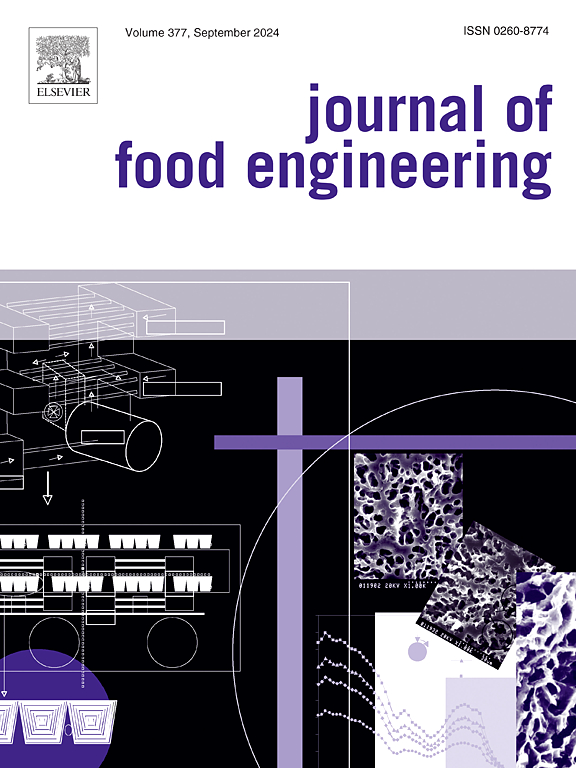Co-crystallized carotenoid extract from mango (Mangifera indica L.) peel as innovative ingredient dye and sweetener in gelatin
IF 5.8
2区 农林科学
Q1 ENGINEERING, CHEMICAL
引用次数: 0
Abstract
Mango (Mangifera indica L.) by-products, such as peels, are promising sources of carotenoids. This study focused ultrasound assisted ethanol-based extraction of carotenoids from ‘Tommy Atkins’ mango peel, followed by their encapsulation using co-crystallization with sucrose, saccharin, and xylitol. The use of co-crystals as a natural dye in gelatin was also evaluated over 42 days (powder) and 7 days (ready-to-serve). Three gelatin formulations were developed: 100 % sucrose (GSC), 75 % sucrose with 25 % saccharin (GSS), and 100 % xylitol (GLX), aiming to provide reduced and sugar-free products. An extraction yield of 139.08 μg g−1 of dry matter was achieved (94.42 % extraction efficiency), β-carotene was identified as the predominant carotenoid in mango peel. The encapsulation efficiency of the co-crystallized carotenoids ranged between 50.62 and 51.86. Scanning electron microscopy of the co-crystals revealed the formation of agglomerates and a porous surface, suggesting carotenoid entrapment. The co-crystals exhibited moisture content ranging from 0.22 % to 1.37 % and water activity between 0.59 and 0.68. During storage, the color of the co-crystals shifted towards more yellowish tones with reduced saturation. FTIR spectra of the co-crystals indicated matrix integrity, with absorption band shifts. DSC and XRD analyses demonstrated the influence of carotenoids on the crystalline structure of the co-crystals. Xylitol cocrystals and powder GSC showed the least color variation. All ready-to-serve gelatins demonstrated similar total color differences over 7 days. The findings confirmed the feasibility of ultrasound-assisted ethanol extraction and the application of carotenoids in a hydrophilic food matrix, highlighting their potential as a natural dye and an innovative dual-function ingredient.
芒果(Mangifera indica L.)果皮共结晶类胡萝卜素提取物作为创新成分染料和明胶甜味剂
芒果(Mangifera indica L.)的副产品,如果皮,是类胡萝卜素的有希望的来源。本研究的重点是超声辅助乙醇提取“Tommy Atkins”芒果皮中的类胡萝卜素,然后将其与蔗糖、糖精和木糖醇共结晶进行包埋。在凝胶中使用共晶作为天然染料的情况也在42天(粉末)和7天(即食)内进行了评估。开发了三种明胶配方:100%蔗糖(GSC), 75%蔗糖加25%糖精(GSS)和100%木糖醇(GLX),旨在提供还原性和无糖产品。干物质提取率为139.08 μg−1(提取率为94.42%),β-胡萝卜素为芒果皮中主要的类胡萝卜素。共结晶类胡萝卜素的包封率在50.62 ~ 51.86之间。扫描电子显微镜显示,共晶形成团块和多孔表面,表明类胡萝卜素包裹。共晶的含水量在0.22% ~ 1.37%之间,水活度在0.59 ~ 0.68之间。在储存过程中,共晶的颜色随着饱和度的降低而向更偏黄的色调转移。共晶的FTIR光谱显示基质完整,吸收带移位。DSC和XRD分析证实了类胡萝卜素对共晶结构的影响。木糖醇共晶和粉末GSC的颜色变化最小。所有即食明胶在7天内显示出相似的总色差。研究结果证实了超声辅助乙醇提取和类胡萝卜素在亲水性食品基质中的应用的可行性,突出了它们作为天然染料和创新双功能成分的潜力。
本文章由计算机程序翻译,如有差异,请以英文原文为准。
求助全文
约1分钟内获得全文
求助全文
来源期刊

Journal of Food Engineering
工程技术-工程:化工
CiteScore
11.80
自引率
5.50%
发文量
275
审稿时长
24 days
期刊介绍:
The journal publishes original research and review papers on any subject at the interface between food and engineering, particularly those of relevance to industry, including:
Engineering properties of foods, food physics and physical chemistry; processing, measurement, control, packaging, storage and distribution; engineering aspects of the design and production of novel foods and of food service and catering; design and operation of food processes, plant and equipment; economics of food engineering, including the economics of alternative processes.
Accounts of food engineering achievements are of particular value.
 求助内容:
求助内容: 应助结果提醒方式:
应助结果提醒方式:


